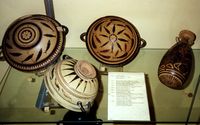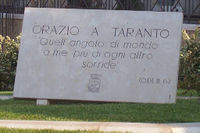Taranto
| Taranto | |
|---|---|
| — Comune — | |
| Comune di Taranto | |
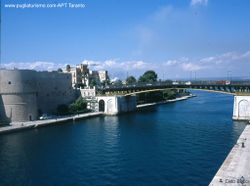 |
|
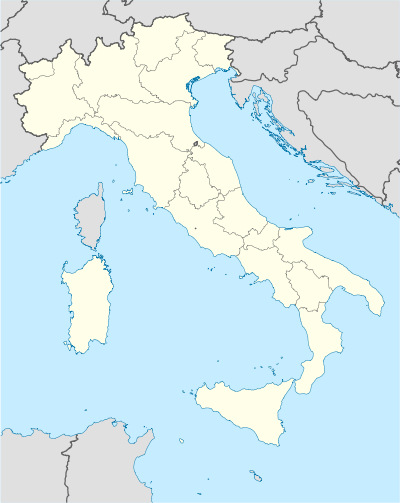 Taranto
|
|
| Coordinates: | |
| Country | Italy |
| Region | Puglia |
| Province | Taranto (TA) |
| Frazioni | Talsano, Lido Azzurro, Lama, San Vito |
| Government | |
| - Mayor | Ippazio Ezio Stefàno |
| Area | |
| - Total | 217 km2 (83.8 sq mi) |
| Elevation | 15 m (49 ft) |
| Population (1 January 2008) | |
| - Total | 195,130 |
| - Density | 899.2/km2 (2,329/sq mi) |
| Demonym | Tarantini or Tarentini |
| Time zone | CET (UTC+1) |
| - Summer (DST) | CEST (UTC+2) |
| Postal code | 74121 (city) 74122 (Talsano) 74123 (Gandoli-Lido Azzurro) |
| Dialing code | (+39)099 |
| Patron saint | San Cataldo |
| Saint day | May 10 |
| Website | Official website |
Taranto listen (Italian pronunciation: [ˈta(ː)ranto], Latin: Tarentum; Ancient Greek: Τάρᾱς Tarās; Modern Greek: Τάραντας Tarantas; Taranto's dialect "Tarde") is a coastal city in Apulia, Southern Italy. It is the capital of the Province of Taranto and is an important commercial port as well as the main Italian naval base.
It is the third-largest continental city of southern Italy: according to the 2001 census, it has a population of 201,349.
Taranto is an important commercial and military port. It has well-developed steel and iron foundries, oil refineries, chemical works, some shipyards for building warships, and food-processing factories.
Contents |
Overview

Taranto's pre-history dates back to 706 BC when it was founded as a Greek colony. The ancient city was situated on a peninsula, protected by a helm; the modern city has been built over the ancient Greek necropolis.
The islets of S. Pietro and S. Paolo (St. Peter and St. Paul) protect the bay, called Mar Grande (Big Sea), where the commercial port is located. Another bay, called Mar Piccolo (Little Sea), is formed by the old city, and there fishing is flourishing; Mar Piccolo is a military port with a strategic importance.
At the end of the 19th century, a channel was excavated to allow the military ships to enter Mar Piccolo harbour, and the ancient Greek city become an island. In addition, the islets and the coast are strongly fortified. Because of the presence of these two bays, Taranto is also called “the city of the two seas”.
The Greek colonists from Sparta called the city Taras (Τάρας), after the mythical hero Taras, while the Romans, who connected the city to Rome with an extension of the Appian way, called it Tarentum.
The natural harbor at Taranto made it a logical home port for the Italian naval fleet before and during the First World War. During World War II, Taranto became famous as a consequence of the November 1940 British air attack on the Regia Marina naval base stationed here, which is today called the Battle of Taranto.
Taranto is also the origin of the common name of the Tarantula spider family, Theraphosidae, even though strictly speaking there are no members of Theraphosidae in the area. In ancient times, residents of the town of Taranto, upon being bitten by the large local Wolf Spider, Lycosa tarentula, would promptly do a long vigorous dance like a Jig. This was done in order to sweat the venom out of their pores, even though the spider's venom was not fatal to humans. The frenetic dance became known as the Tarantella.
History
Taranto was founded in 706 BC by Dorian Greek immigrants as the only Spartan colony, and its origin is peculiar: the founders were Partheniae, sons of unmarried Spartan women and Perioeci (free men, but not citizens of Sparta); these unions were permitted by the Spartans to increase the number of soldiers (only the citizens of Sparta could become soldiers) during the bloody Messenian wars, but later they were nullified, and the sons were forced to leave. Phalanthus, the Parthenian leader, went to Delphi to consult the oracle: the puzzling answer designated the harbour of Taranto as the new home of the exiles. The Partheniae arrived in Apulia, and founded the city, naming it Taras after the son of the Greek sea god, Poseidon, and of a local nymph, Satyrion. According to other sources, Heracles founded the city. Another tradition indicates Taras as the founder of the city; the symbol of the Greek city (as well as of the modern city) depicts the legend of Taras being saved from a shipwreck by riding a dolphin that was sent to him by Poseidon. Taranto increased its power, becoming a commercial power and a sovereign city of Magna Graecia, ruling over the Greek colonies in southern Italy. Its independence and power came to an end as the Romans expanded throughout Italy. Taranto won the first of two wars against Rome for the control of Southern Italy: it was helped by Pyrrhus, king of Greek Epirus, who surprised Rome with the use of elephants in battle, a thing never seen before by the Romans. The second war was conversely won by Rome, which subsequently cut off Taranto from the centre of Mediterranean trade, by connecting the Via Appia directly to the port of Brundisium (Brindisi).
Taranto as a centre of ancient art
Like many Greek city states, Taras issued its own currency in the 5th and 4th centuries B.C. The denomination was a Nomos, a die-cast silver coin whose weight, size and purity were controlled by the state. The highly artistic coins presented the symbol of the city, Taras being saved by a dolphin, with the reverse side showing the likeness of a hippocamp, a horse-fish amalgam which is depicted in mythology as the beast that drew Poseidon's chariot.
Taras was also the center of a thriving decorated Greek pottery industry during the 4th century BC. Most of the South Italian Greek vessels known as Basilican ware were made in different workshops in the city.
Unfortunately, none of the names of the artists have survived, so modern scholars have been obliged to give the recognizable artistic hands and workshops nicknames based on the subject matter of their works, museums which possess the works, or individuals who have distinguished the works from others. Some of the most famous of the Apulian vase painters at Taras are now called: the Iliupersis Painter, the Lycurgus Painter, the Gioia del Colle Painter, the Darius Painter, the Underworld Painter, and the White Sakkos Painter, among others.
The wares produced by these workshops were usually large elaborate vessels intended for mortuary use. The forms produced included volute kraters, loutrophoroi, paterai, oinochoai, lekythoi, fish plates, etc. The decoration of these vessels was red figure (with figures reserved in red clay fabric, while the background was covered in a black gloss), with overpainting (sovradipinto) in white, pink, yellow, and maroon slips.
Often the style of the drawings are very florid, and frilly, as was already the fashion in Fourth-Century Athens. Distinctive South Italian features also begin to appear. Many figures are shown seated on rocks. Floral motifs become very ornate, including spiraling vines and leaves, roses, lilies, poppies, sprays of laurel, acanthus leaves, etc. Often the subject matter consists of naiskos scenes (scenes showing the statue of a deceased person in a naos, a miniature temple or shrine). Most often the naiskos scene occupies one side of the vase, while a mythological scene occupies the other. Images depicting many of the Greek myths are only known from South Italian vases, since Athenian ones seem to have had more limited repertoires of depiction.
|
Environment
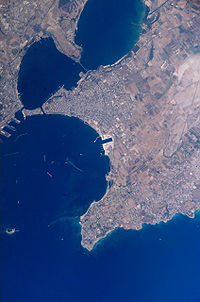
As a consequence of the poisons discharged into the air by the factories on its territory, Taranto is the most polluted city in Italy and western Europe. As a matter of fact, only 7% of Taranto's pollution is inhabitants-related: 93% is factories-related.
Every year Taranto's inhabitants inhale 2.7 carbon monoxide tons and 57.7 carbon dioxide tons. The latest data provided by the INES, the Italian national institute of emissions and their sources (Inventario nazionale delle emissioni e loro sorgenti), confirm that Taranto stands comparison with the Chinese Linfen and the Romanian Copşa Mică, the most polluted cities in the world due to factories' emissions.
In particular, Taranto has dioxin. 92% of the Italian dioxin is produced there and, in other terms, 8.8% of the European one. In ten years, leukaemias, myelomas and lymphomas increased by 30–40%. Furthermore, the dioxin accumulates over the years: so far at least 9 kilos of dioxin have been discharged into Taranto's air by its factories, i.e. three times the quantity discharged in the Seveso disaster (the one in 1976 where the Italian city Seveso was contaminated by dioxin).
Municipality bankrupt
The Municipality of Taranto was declared bankrupt because - as ascertained by Francesco Boccia, chief of the liquidation committee - as of 31 December 2005, it had accrued liabilities in an amount equal to 637 million euros. This is one of the biggest financial crises which has ever hit a municipality.
The fact that the municipality went bankrupt was officially declared on 18 October 2006 by the receiver Tommaso Blonda, appointed further to the resignation of the mayor, Rossana Di Bello, following her one-year-and-four-months imprisonment conviction for abuse of office and documental forgery in relation to investigations made on the contract for the management of the city incinerator given to the company Termomeccanica.
Main sights
Taranto has a number of sites of historic value. Sitting along the Little Sea, The Aragonese Castle was built in the 15th century with the intention to protect the town from the Turks' frequent raids. The castle replaced a pre-existing fort which was deemed unfit for 15th century warfare.
The old town, including Piazza Fontana, Saint Domenico's church, Madonna della Salute Sanctuary, and a number of old palazzi, is standing exactly as it did a thousand years ago, when the Byzantines rebuilt what the Saracens had razed to the ground in 927 AC. The picturesque alleyways, arches and stairwells, along with the old craftsmen workshops, contribute to its unique atmosphere.
Taranto features several Greek temple ruins - some stretching as far back as the 6th century BC - such as the remains of a Doric Temple still visible on Piazza Castello.
A number of 18th-century palazzi adorn the town centre. For years, they served as the main residence of local aristocratic families and these include Palazzo Carducci-Artenisio (1650), Palazzo Galeota (1728) and Palazzo Latagliata.
The Ponte Girevole (swing bridge), built in 1887, runs across the navigable ship canal that joins Mar Piccolo (Little Sea) with Mar Grande (Big Sea) and stretches along 89.9 meters or 294.95 ft. During its opening, the two ends of the city are literally left without connection.
A really important institution of Taranto is the "Galileo Ferraris" high school,founded in 1848, located in via Mascherpa 10. This school is famous for his highly-developed level of instruction, because of its high quality level of teachers and students. Others schools are: IIS Archita, IIS Quito Ennio, IIS Aristosseno, and ITIS Pacinotti.
The Promenade (lungomare), named after former Italian king Victor Emmanuel III, overlooks the Mar Grande, with the imposing views of its natural harbour and commercial port.
Notable people
These historical figures have had a relationship with the city. Not all of them were actually born in Taranto.
- Archytas of Tarentum, philosopher, mathematician, astronomer, statesman, strategist and commander-in-chief of the army of Taranto;
- Philolaus, mathematician and philosopher.
- Aristoxenus, peripatetic philosopher, and writer on music and rhythm;
- Leonidas of Tarentum, poet;
- Lysis of Tarentum, philosopher;
- Rhinthon (c. 323–285 BC), dramatist;
- Livius Andronicus, poet;
- Titus Quinctius Flamininus, propraetor of Tarentum;
- Pacuvius, tragic poet, died in Tarentum in 130 BC;
- Cataldus, archbishop and patron saint of Taranto;
- Bohemond of Taranto, key military leader on the First Crusade
- Gil Albornoz, archbishop of Taranto in 1644;
- Giovanni Paisiello, composer;
- Pierre Choderlos de Laclos, Napoleonic army general and novelist, died in Taranto;
- Etienne-Jacques-Joseph-Alexandre MacDonald (1765–1840), duke of Taranto and marshal of France;
- Marcus Fulvius Nobilior, rumoured to have been born here and not Rome as was first assumed.
- Michael of Taranto, Master hazmat chief of the east coast and creator of the stamp and go method.
- Riccardo Tisci, fashion designer, creative director of Givenchy
Citations
Dearest of all to me is that nook of earth
which yields not to Hymettus for its honey, nor for its olive to green Venafrum;
where heaven grants a long springtime and warmth in winter,
and in the sunny hollows Bacchus fosters a vintage noble as the Falernian.—Horace, To Septimius (Odes, II. 6, 13-20)
Dicas adductum propius frondere Tarentum.—Horace, To his friend Quinctius, telling that a lovely place in country may look like the leafy Taranto. (Epistula I, 16, 11)
Miscellaneous
- Star of David: "A David's shield has recently been noted on a Jewish tombstone at Tarentum, in southern Italy, which may date as early as the third century of the common era."
- Tarentum was included in the hit PC game Rome: Total War as the governing settlement for Apulia as well as the capital of the Roman Faction of Brutii
- Taranto fortress is the sign of this city.
References
- Notes
External links
- Official website
- Taranto Jewish History
- Culture Centre Filonide
- Hotel Palace
- Tourism in Taranto
- Holy Week Rites in Taranto, Italy (website in English and Spanish)
- MARTA: Museo nazionale ARcheologico TAranto (Taranto Archaeological National Museum)
- Word of the Day: Tarantula and Tarantella, From Taranto, etymology and folklore
|
|||||

